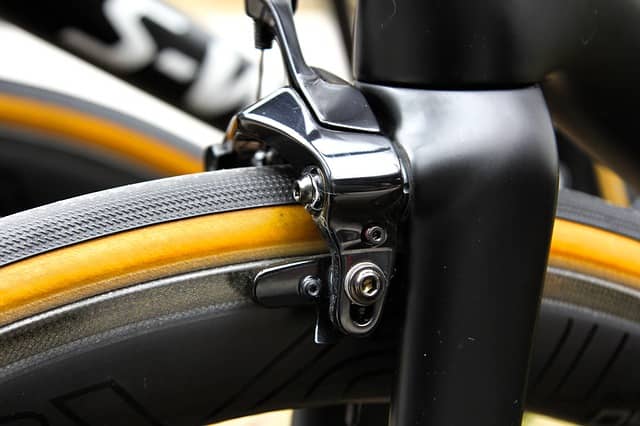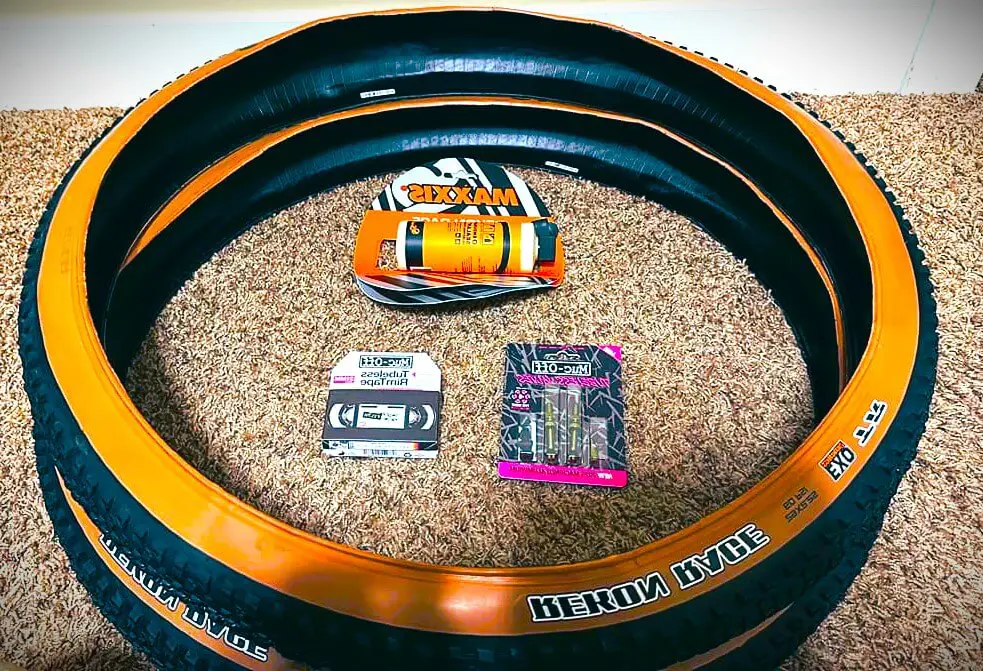How Long do Bike Brake Pads Last? | Rim Vs Disc Comparison In 2024!

As an affiliate, we may earn from qualifying purchases. We get commissions for purchases made through links on this website. You can read more on our Affiliate Disclaimer here.
How long do bike brake pads last? As a new biker, you may think you don’t have to spend much on maintenance like fuel or engine costs. That said, there are certain bike maintenance demands that do require your attention. One of them is your bike brake pads. So the question is ‘How long do bike brake pads last?’
Factors that Impact Your Brake Pads:
Well, that depends on a lot of factors, actually. All the way from the material of your brake pads to the way you use your bike and everything in between. So let’s discuss those everything-in-between including the two ends, starting from your brake compound.
Brake Compound:
So what exactly is a brake compound? Look at your brake pad and you’ll notice a very textured and scratchy side. Voila! That’s the brake compound. Brake compounds are made of various materials. Each is briefly discussed below:
Organic:
- Made of rubber, glass, carbon, and held together by resin
- Best in warm and dry weather conditions
- Produces less heat
- Performance declines on wet and steep terrains.
- Appearance gradually becomes dull.
- Suitable for the everyday cyclist who has no aspirations of competitive cycling.
Sintered:
- Made of metallic components fused together
- Very weather-resistant
- Quite powerful
- Quite durable
- Creates noise
- Suitable for more aggressive cyclists.
Semi-metallic:
- About half made of, as the name suggests, metallic components and the rest from carbon or other filler components.
- A step up from organic brake compounds but a step down from sintered compounds in terms of durability.
- Quite weather-resistant.
- Quite powerful.
- Makes less noise than sintered compounds.
- Puts less stress on the rotor than ceramic brake pads.
- Appearance can still become dull, but this depends on the sintered-to-organic ratio.
- Suitable for taking tours and doing endurance sports.
Ceramic:
- Made of ceramic, duh!
- The most expensive of the bunch.
- Very weather-resistant.
- Very quiet.
- Suitable for amateur racers, but not competitive racing.
Rim vs Disc Brake Pads:
There are mainly two types of brake pads: Rim and Disc. It is not so simple that one is better than the other, as each one has advantages and disadvantages that you should look at and see which pad fits you best.
Below is a comparison table of the two types:
| Rim Brake Pad | Disc Brake Pad | |
| How they work | Braking pressure is applied to the wheel from the outside of the rim. | Braking pressure is applied to a rotor (mounted to the tire’s hub) instead of the wheel. |
| Newer or older technology |
|
|
| Pros |
|
|
| Cons |
|
|

As apparent from the table, disc brake pads are the superior type, but that does not mean rim brake pads are incompetent. It may just come down to your budget, which we now get to.
How Much Do Brake Pads Cost?
As just mentioned in the above table, pricing depends on the make, on the material. Now how much exactly is cheap and how much is expensive? Well, though the range may vary, a useful range to consider for rim brake pads is $10 – $30, whereas the average range for disc brake pads is $20 – $40.
This price is only for the cost of the brake pads. The price spikes if you want a professional to set them up on your bike. The average cost for that — (pad cost + labor cost + processing cost) — may go from $35 to even more $200!
Durability:
Brake pads exist for braking, right? So of course they are built tough with the consideration that they will face pressure from strong clutches and sudden braking when needed. Though disc brakes are more durable than rim brakes, it is not the case that the latter are fragile. Indeed, brake pads are intended to be durable.
But it is important not to take advantage of the tough material of the brake pads. Sudden braking can and will wear down the pads, whether they be made of organic materials or sintered.
Bike Brake Pads Lifespan: How Long Do Brake Pads Last on Average?
Alright, now we know that brake pads do wear down. But how long do they last? On average, brake pads last anywhere between 500 and 1250 miles. Quite a big range, if you ask us.
Factors that Affect Brake Pad Lifespan:
Well, why exactly is there such a big range? There are a lot of answers to that “why,” which we will now get to.
»Types of brake pads
This should be obvious, but the make of the pads largely determines the wear and tear they can withstand. Resin-based organic pads can take a toll of about 500-700 miles, whereas metallic and sintered ones can pull through a thousand and above miles.
»Breaking habits
We mentioned strong clutches and sudden braking, remember? These are quite bad braking habits. Not only for bicycles but for any vehicles — be it cars, vans, rickshaws. The friction generated from sudden braking not only affects the braking pads, but also the wheels and, potentially, the rider as well.
Here’s one token of advice: slow down beforehand rather than suddenly putting on the brakes, and lean back slightly (extreme caution needed here) to reduce the aerodynamics. Well, that’s two tokens of advice. Well, in that case, take one more: when it rains, brake slowly and beforehand — this applies to car brakes as well.
»Weather factors
As you should clearly know by now, weather resistance is an important quality of brake pads. While it may be common sense to realize that rain and snow have a negative impact on brake pads and the braking mechanism, brake pads are even more vulnerable to heat due to an exponential rise in friction.
Whether in the heat or the cold or the slippery terrain of rain, ceramic and sintered pads are very weather-resistant, whereas organic resin-based pads see performance decline.
One nuanced piece of tidbit here: hydraulic bikes are best at cold temperatures up to -26 degrees celsius, but for even lower temperatures, down to -41 degrees celsius, the metallic and organic brake pads function better. Most probably this distinction won’t affect you, though. But just in case.
»Terrain
A similar point touched upon in the last paragraph relates to terrain or the ground. Of course, the weather transforms the terrain to slippery or filled with obstacles like hail or debris.
But even disregarding weather conditions, the terrain can very well differ, such as in slope surfaces and rough and damaged roads. That’s why special bikes are designed to trek mountains, like mountain bikes. But for ordinary usage, just be careful when treading rough terrains.

When to Change Brake Pads:
Now that we know what causes brake pads to deteriorate, the next question is the featured question: when to change brake pads. What are the symptoms? How do we know when the time comes to replace brake pads?
Easy. Just take a look at them. Keep an eye on these pads after a few months of buying. It will also obviously depend on how much you use them, as some people may use up the entire mileage within a few months. A rule of thumb is to replace the pads if their thickness deteriorates down to 1-1.5 mm. When newly bought, the thickness is typically 3-5 mm, so rest easy until the pads lose thrice their thickness.
Changing Brake Pads:
Now just one question remains. How are brake pads changed? We recommend you opt for a professional. Your local bike store should be more than able to do the job for you.
As mentioned, the price range is big — from $35 to over $200 — depending on circumstances. Even if you buy the bike pads from Amazon, you can take them to the store and have them install the pads on your bike.
Another obviously important thing to keep in mind is the shape of your bike pad. Yes, some are bigger than others, and not all will fit on your bike’s brake calipers. All you need to do is to look at the caliper’s body and see what shape it is (there is a name). Or simply just double-check your current brake pads and buy a pair that matches that shape. Simple.
Summary
Bike Pad Materials: Organic, Sintered, Semi-Metallic, Ceramic
Types: Rim, Disc
Average Price Range: $10 – $30 (Rim), $20 – $40 (Disc)
Mileage: 500-750 miles (Organic, Resin-based), 1000-1250 miles (Metallic, Sintered)
Factors that affect brake pads: Brake Pad Types, Breaking Habits, Weather Factors, Terrain
Final Thoughts:
If your bike’s brake pads fail, then a lot may be on the line than just the replacement costs. Even if the braking system doesn’t completely fail, damaged brake pads are a hazard to not only the bike’s safety but also yours. But the signs of bike pads needing replacement are quite easy to trace. And so by reading this, you now know how long bike brake pads last.
FAQs Of How Long Do Bike Brake Pads Last!
Is there any difference between Organic Brake Compounds and Resin Brake Compounds?
We’ve seen some people being confused about the terminology.
No. There’s no difference between the two. Organic Brake Compounds are made of glass, fiber, Kevlar, rubber. And these are based on resin — and thus the alternate name being Resin Brake Compounds.
You may also find other subtypes of brake compounds such as Low-Metal Brake Compounds. This just means the metal component is low. We have not gone through all possible iterations in our discussion but instead have outlined the four main types: organic, sintered, semi-metallic, and ceramic.
Can I possibly use two different pads on my bike?
Yo, that’s my man! Love that outside-the-box thinking. We say, why not? Actually, it is a very good idea for two reasons. One: you experiment with different pads and see which works best for you. Two: you use a sintered or a semi-metallic brake pad as the rear brake pad for durability, and an organic brake pad for an easier grasp and feel. The best of both worlds!
I prefer organic brake pads but I hate that they lose their glaze.
Is there a way to maintain the glaze?
We know exactly what you mean. Well, we could tell you to go easy on the brake pads but that’s neither practical (to a certain extent) nor a long-term solution. Therefore, our advice is to give them a glaze makeover!
We mean, you can do some maintenance on worn-down pads by adding some light filling to the pads or just using some sandpaper. However, those won’t make them as good as new. So we recommend not overly relying on patching the pads up. Instead, replace them when the thickness gets below 1.5 or at most 1 mm.
Do brake pads need a warm-up before they function properly?
An interesting question relates to the physics of friction. The answer is yes and no. No for organic pads. Yes for metallic and sintered pads. Why? Because metals are heat conductors and resin is an insulator.
This also means that in cold temperatures, metallic brake pads won’t work as well as organic ones. One way to get around this problem and also have the durability of metal-based components is to opt for a semi-metallic brake pad which is a combination of organic and sintered brake pads.
That being said, the initial warm-up required by the metallic brake pads shouldn’t be a major problem since we don’t brake nonstop right after getting on our bike.
Why are high-temperature conditions a problem for metallic bike pads?
Again, physics! Although friction is needed, too much heat can cause heat to be transferred to the rotor and cause damage. In fact, extremely hot temperatures are much more of a hazard than cold temperatures.

Steven is a professional cyclist and his passion is cycling. He has been cycling for the last 6 years and he loves using bikes while outing as well. Based on his experiences with the different types of bikes; he is sharing his opinions about various bikes so that a beginner can start right away. Find him on Twitter @thecyclistguy Happy Biking.




